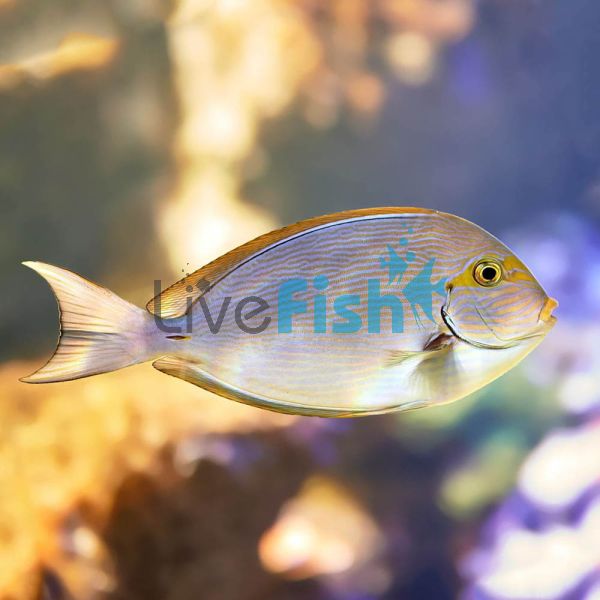Tang Yellow Eye - Medium
This fascinating species of tang will dazzle in any large aquarium setup for years to come. Once fully grown they will make impressive additions to the tank purely because of how big they can get with proper care.
Yellow Eye Tang
The Yellow Eye Tang has a flat elongated disc-shaped body with a brownish metallic colouring. The distinctive yellow bar across its eye gives them their name. This species of tang has the ability to change it colour from light blue to a darker shade of brown.
This species is difficult to breed in captivity due to the fact that it can be quite hard to spot differences between the sexes.
The Yellow Eye Tang like other tangs has a sharp scalpel-like spine located on its tail which it uses as a defence mechanism so be extra cautious when attempting to handle one.
These fish are originally found all over the West Indian and Pacific Oceans ranging from the Gulf of Oman and the Red Sea over to Japan and Western Australia. They hang around steep slopes located in the vicinity of coral reefs at depths of up to 45 metres. The adults are often seen in schools and sometimes even on their own along rocky bottom patches.
Tank Recommendations for Yellow Eye Tang
The smallest tank size for these fish is 1300 litres as they can grow extremely large, even up to 20 inches in some cases. They will do well in both fish only and reef aquarium environments but make sure they have a lot of wide-open swimming areas. The Yellow Eye Tangs love turbulent water so be sure to provide at least one area with plenty of moderate water movement. Some nooks and overhangs can be established as well as live rock for grazing as long as the required amount of swimming area are available.
Suitable Tank Buddies
They will most likely be aggressive towards other members of the same family so only keep one at a time in a typical home aquarium setup. They will get along well with most types of other fish as long as they don't look too similar.
Usually Compatible
Angelfish, Blennies, Boxfish and Clownfish would make an excellent combination with this Tang. Other species which should not have any problems are Dragonets, Damselfish, Groupers and Grunts. Lionfish, Parrotfish, Snappers and Wrasses would make wonderful tank buddies as well.
Sometime Compatible
Batfish and Butterflyfish may be problematic so choose which ones you have carefully. Other species that can sometimes cause aggression are Cardinalfish and Triggerfish. Keep an eye on them if you have any Rays in the aquarium also.
Rarely Compatible
Peaceful and docile species such as Pipefish and Seahorses will be too intimidated by the Tang to come out and eat and will more than likely starve to death. Predatory Sharks will actively hunt them as well so avoid those too.
Feeding Your Yellow Eye Tang
These fish are omnivores and in the wild will spend their time grazing algae from rocks and consuming zooplankton mid-water. For this reason, provide them with a variety of vegetable foods around 3 times a day along with meaty foods such as mussel and fish flesh. Vegetables should include spirulina and other green offerings such as broccoli and even vegetable flakes. Live rock with a good population of micro-algae is essential when keeping this species of tang. Dried nori seaweed should be clipped against rocks if algae growth is insufficient.
| Scientific Name | Acanthurus mata |
|---|---|
| Care Level | Moderate |
| Common Names | The Yellow Eye Tang is also known as the Elongate Surgeonfish and the Mata Tang. |
| Diet | Omnivore |
| Fish Family | Acanthuridae |
| Lifespan (years) | 20 |
| Max. Length (cm) | 51 |
| Min. Tank Volume (l) | 1300 |
| Origin | Indo-Pacific |
| Reef Safe | Yes |
| Sociability | Semi-aggressive |
| Venomous | No |
| Water Conditions | 22.2-27.8° C (72-82° F), dKH 8-12, pH 8.0-8.5, sg 1.020-1.025 |




